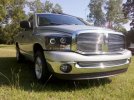Cravenfan
Well-Known Member
I have a nervous tick, or twitch at every stop sign and redlight...I want to race everyone. 
My 5.7 ticks a bit, usually on cold start up...less than my prior Denali, way less than my Dad's Ford.
Not sure why this would bother anyone...crank the tunes and rip it.
My 5.7 ticks a bit, usually on cold start up...less than my prior Denali, way less than my Dad's Ford.
Not sure why this would bother anyone...crank the tunes and rip it.












